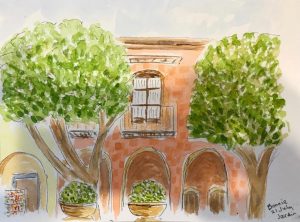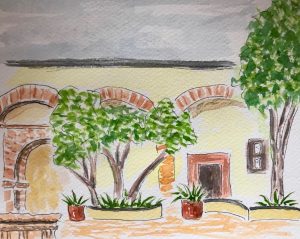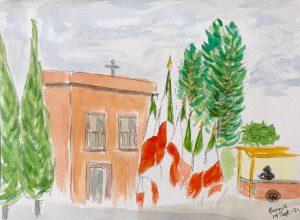My third grade art teacher walked around our classroom as if looking for trouble. I kept my head down and concentrated on the subject we were supposed to be drawing. This teacher was a tall man, bone-thin — like a clothed skeleton in a furry black wig, I thought. Scary. Never smiling. Always criticizing.
When he got to my desk, he stopped, bent over, wrapped one skeletal arm around my shoulder, and pressed the side of his head against mine. Then he growled:
“Not like THAT!” He yanked the pencil from my hand and imitated my short, light, feathery lines, mockingly. His breath smelled sour. “Like THIS,” he shouted. Then, with his long, bony right hand, he drew a dark arc across the top of my paper, nearly tearing it.
All of my classmates looked in my direction. I wanted to slither from my seat onto the floor. Clearly, I had made this art teacher angry. Clearly, I had failed. I knew I could never put that much anger into a drawing; I just didn’t have it in me. I suddenly felt I wasn’t any good at art after all.
I came from an artistic family, but in that moment I thought I must have missed out on the art gene. Both of my grandfathers had been artists. My mother was an excellent amateur oil painter in her spare time, my sisters were artistically gifted, one of them was to become a successful professional.
But that day in that third-grade classroom something froze in me. Ever since then my rare drawing and painting endeavors have never risen above the third-grade level.
I realized this only recently when I shared one of my sketches online with the Urban Sketchers San Miguel de Allende Facebook group I belong to. I commented: “All of my sketches look like they were done by a third-grader. Maybe that’s because the artist in me is still in third grade (and chooses to stay there)?”
One of the many pluses of aging, I feel, is that given enough time and careful thought, things begin to make sense. Like that art teacher, for instance. I can understand better now why he was always so angry. He didn’t want to be there, teaching art in a small grammar school lost in the weeds of suburban New Jersey. He wanted to be an artist. He wanted to spend his days taking his ferocious energy and splashing it over stretched canvases in fiery colors. His rage that day had nothing to do with me.
Similarly, I understand better now my father’s frequent rages. Like a large animal in a small cage, he felt trapped in suburbia, working at an uncreative nine-to-five office job for a corporation he cared nothing about to support an ever-growing family he didn’t want. He felt he was meant for better things. So he took his anger out on others — his waiflike wife and the small innocents around him under his roof — behind closed doors.
I’m guessing this was true of countless American men of their generation: They felt caged, manacled, duped. My father and that art teacher were not alone in this. Arthur Miller’s 1949 Pulitzer Prize-winning tragedy, Death of a Salesman, considered one of the greatest plays of the twentieth century, spoke to millions. Its protagonist Willy Loman became emblematic of the many misfits in America’s merciless economic machinery.
Much later in our lives, my mother urged me to take up painting – if not oil painting, which she preferred, then watercolor, which was “softer,” she said, more suited to me.
“Sorry, Mommy,” I told her, “but I’m way too busy for that right now. I’ve got to make a living.”
“Well, then, do it when you retire,” she said. “I know you will love it and it will make you happy.”
So when I finally retired at seventy and came to live in San Miguel de Allende, Mexico, six years ago and later heard about the Urban Sketchers group here, I had to investigate. I learned that Urban Sketchers San Miguel de Allende is a regional chapter of Urban Sketchers International, a nonprofit dedicated to fostering a global community of artists who practice on-location drawing (www.urbansketchers.org).
Our local group, most of whom are expat retirees trying our hand at art, has, after a long COVID hiatus, resumed gathering every other week at a different designated spot, where we fan out — masked and socially distanced — to sketch and paint whatever strikes our fancy at that location. Afterward, we share our sketches on the group’s Facebook page.
Here are a few of my most recent sketching/painting efforts:



Yes, the watercolor painter in me is, and will likely remain, a third-grader. She’s a nice kid. Quiet. Shy. She has no intention of ever becoming a professional visual artist when she grows up. She doesn’t welcome judgy critiques or free advice on how she could or should improve. She just wants to sit alone in front of a pleasing outdoor scene, pick up a long, thin, tapered brush, swirl it in some soft, watery colors, and have fun freely painting what she sees.
~ ~ ~ ~ ~
For more information about the Urban Sketchers group in San Miguel de Allende, contact Judy Plummer at www.judyplumj@gmail.com or go to:

Beautiful Bonnie.
Gracias, querida! — xx
The artist in me was squelched when I was 19 and wanted to transfer to an art college. I was told that I had to think about making a living. I have dabbled in various mediums particularly in the fiber arts but I think my passion for making art was permanently squelched. I am merely an appreciater and supporter! It still enriches my life!
Yes, I’m sure you’re not alone either, Suzanne! It’s sad that so many of us had our artistic talents squelched at an early age. But (I like to think) it’s never too late to recapture them.
I love your wise and insightful discourses. You paint wonderful word pictures that delight and move your readers. I related to your childhood experiences. Keep painting with your group. Picasso spent years learning how to paint he human figure, until he reverted to what some would qualify as 3rd grade work, and thus establishing himself as one of the most important modern artists of our time.
Thank you for your kind words, Linda. Yes, I like to think of myself as in the word-picture business. 🙂 Watercolors are for dabbling, just for fun.
I love your watercolors, BonnieDear. Remember when we used to ride our bikes and go painting here in Taos? Well, you painted and I stabbed around at drawing.
That teacher though—such a mean and miserable man. He was probably drinking. What a blessing it is for you to find a way to rationalize his behavior, because then you were able to see that it wasn’t really directed at you. It just felt like it. I’m still feeling sad in the moment for that third-grade Bonnie, but I know she’s transcended. xoxo
Yes, I certainly do remember our bike-ride-and-painting adventures, Be. What fun! (I was in third grade then too.) I’m sure that a whole lot of children have had their budding artistic talents stepped on along the way by angry, thoughtless adults, alas.
These are wonderful watercolors, Bonnie. I don’t see them as third grade level at all! Bravo!
Sweet of you, Lily. Thanks!
Have fun…even as a (new) third grader!
Thanks, Barb! That’s exactly what I intend to do! 🙂
So very lovely, Bonnie. Beautiful and joyful composition. This professional artist and (newly retired) veteran art teacher cringes when reading your story. We hold such a responsibility when teaching children and adolescents. Your story is a perfect example of how fragile the artist inside of us can be. Keep painting and keep joyful.
Thanks so much for your lovely words, dear Barbara. I hope you are enjoying your retirement and joyfully spending time doing your own art now. Best wishes, BB
I can still remember my art teacher in elementary school asking me why I had painted the stars pale green. I answered that it’s because that’s what they are. And to this day the stars STILL look pale green to me. My mother always despaired looking through my school notebook, and would say, “you’re wasting your time drawing,” so that’s what I came to believe: that art is a waste of time.
I don’t think many teachers or parents intend to hurt children, but they manage to do it anyway through ignorance. When I was teaching, another teacher one remarked, “I hate that kid!” When I asked why, she replied, “he asks too many questions,”
As a society, we don’t like people who think outside the box, people who are too “different,” who change their sexual orientation, or have unpopular opinions. As an atheist, what I make of the life of Jesus is that we want to kill people who are too different. Sometime in the seventies, Marlo Thomas produced a wonderful record called “Free to Be You and Me,” which I bought for my youngest son. Now fifty, he told me that a few years ago he heard it at someone’s house and it brought tears to his eyes.
Thank you SO much for sharing these experiences, Athea. Yes, I so agree with you. I’m not an atheist, though; I believe in the God of Creation who wants to continue creating through people who use the creative gifts they were born with. In my (strong) opinion, religious people who stifle their own and others’ creative impulses, don’t know God.
Thank you so much for sharing this blog post! I celebrate that you are still picking up the brush and trying your hand at this! I celebrate you and all of your bravery! Your words and your art are a gift to the World, Bonnie!
Thanks so much for your very kind words, Joseph!
Love it. I enjoy playing with watercolor since a child. Thanks for sharing. I like how you relate your memories with the present urban sketchers art group. The art flows within you ♥️
Thank you, Cynthia. How kind of you to say that. Yes, let’s keep playing with watercolors!
Dear Bon,
Your column this week took me right back to my seventh grade art teacher who used to make students cry. He and your art teacher must have shared the same affliction. I took art all through high school with very modest ability. I didn’t care. It made me feel good about myself. I do want to stress that every other art teacher I had was wonderful and never made me feel like my work was inadequate. As I recall, I had no ability to paint in watercolors.
I think that horrible man is still in your head making you judge your work harshly. Your paintings are lovely and would look charming in a travel book about SMA. You are certainly adept enough to illustrate your own children’s book, and I know children would love your pictures. You should consider writing one, perhaps in both English and Spanish. I know you would write a book the would promote unity and mutual respect, a message that is sorely needed now.
Love,
Paul
Dearest Paul — Would you like to be my literary agent? 🙂 You’re so sweet to suggest a children’s book. Maybe in my next life! … Yes, I’m learning that many WOW readers, like you and me, had nasty art teachers early on. But I like to think we’ve (finally) outgrown them. Abrazos (hugs), BB xx
Hi Bonnie – Loved your sweet but sad story about a tender 3rd grader. Glad you have recovered though and understand where it came from. I loved painting in watercolors. At the New York School of Interior Design where I learned my trade, we had to do all our room designs in water colors. I think it is the most flexible medium for mixing and producing exact colors, more than oil or acrylic. Your paintings are lovely.
Abrazos, Kaye
Hi, Kaye — Thanks so much for sharing this. I can imagine how beautiful your watercolored room designs were! Maybe you could pick up a brush again now? — Abrazos to you, Bonnie
Dear BB,
Thank you for sharing this important story and your lovely paintings. Both Linda Berman and Paul hit the exact points I thought. So many teachers haven’t a clue on the impact they have on children’s lives and how a negative action or word can stay with us all our lives. I’m so happy you’ve picked up your brushes and took your mothers Sage advice. To express how you’ve forgiven that horrible man by understanding his behavior is So You! It’s why I’ve always been and remain one of your biggest fans.
Like your catering career where you created edible works of art, the brilliant way you turned disposable plastic bags into useful items in Africa, not to mention your darling puppets, you’ve always been an Artist! Watercolors were merely waiting in the wings. It makes me smile to see them finally take their day in the spotlight! Your trees are so vibrantly alive I can smell them! Keep them coming!
❤️, MM
Darling Michael — You’ve left me speechless. Thank you for your sweet words and your one-of-a-kind heart. I feel so blessed to have you in my life. Mucho love siempre, Your BB, xx
What a wonderful post! A personal essay with many dimensions and new and important turns.
Thank you so much, dear Sharman! Your feedback has always meant the world to me.
Keep on painting! I’m stretching my imagination back to third grade. I remember my teacher, Mrs. Kornman, but no recollection of an art teacher.
Thanks for the encouragement, Mary Jane! … Yes, that art teacher was particularly memorable. 🙁
A few years ago I began to include sketches in my writing notebooks/journals. I mostly draw my day as I write. It could be my coffee mug or the nail polish I just used. I love your urban art. I haven’t tried that yet but you inspire me. Btw: yes I was the Jersey girl who wrote the review. xo
Dear L. — Great to hear from you! Maybe there’s an Urban Sketchers group near you you might join? I know you’d love it and be really good at it. Yes, you’re my mysterious “Jersey Girl.” Thank you!
I think your paintings are lovely, Bonnie. Very peaceful…
Ah, Susan, that’s very kind of you. How are YOU doing? Do you plan a return trip to SMA? Hope you’re well.